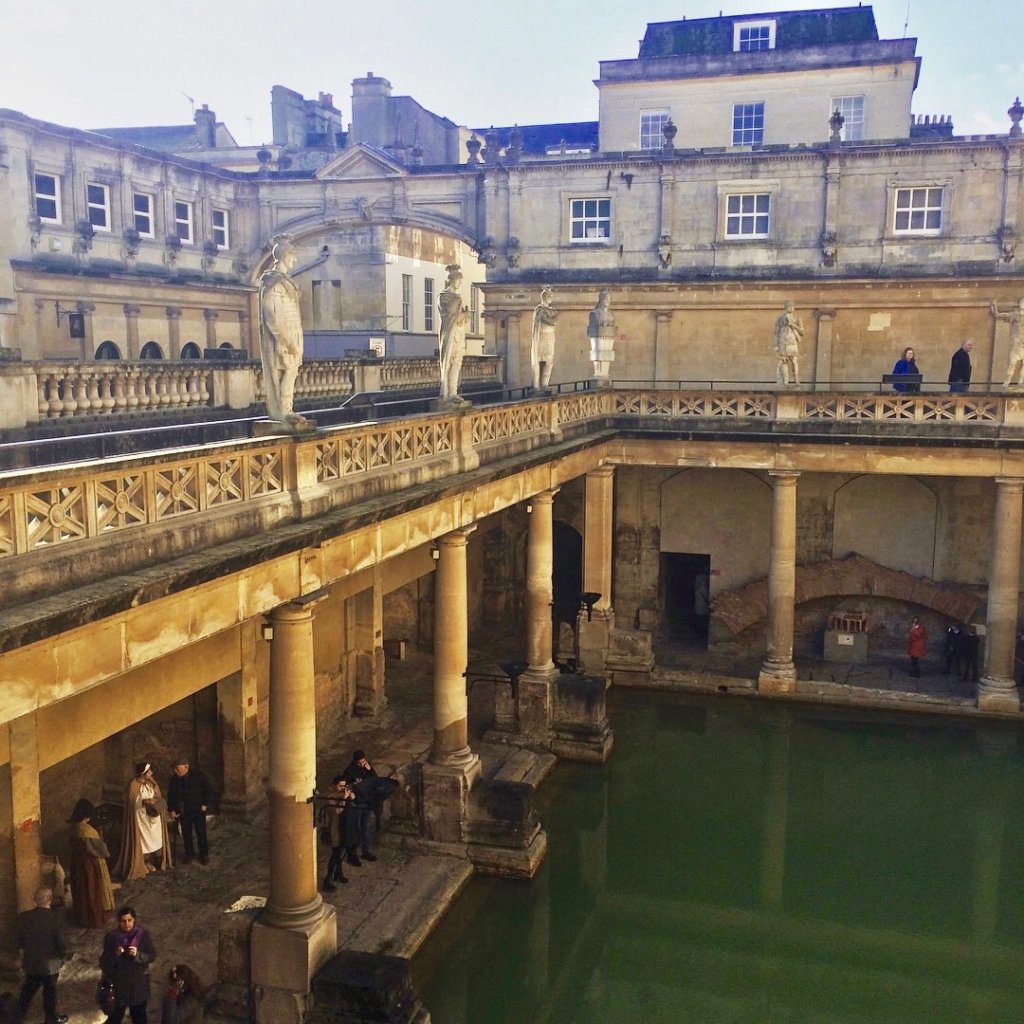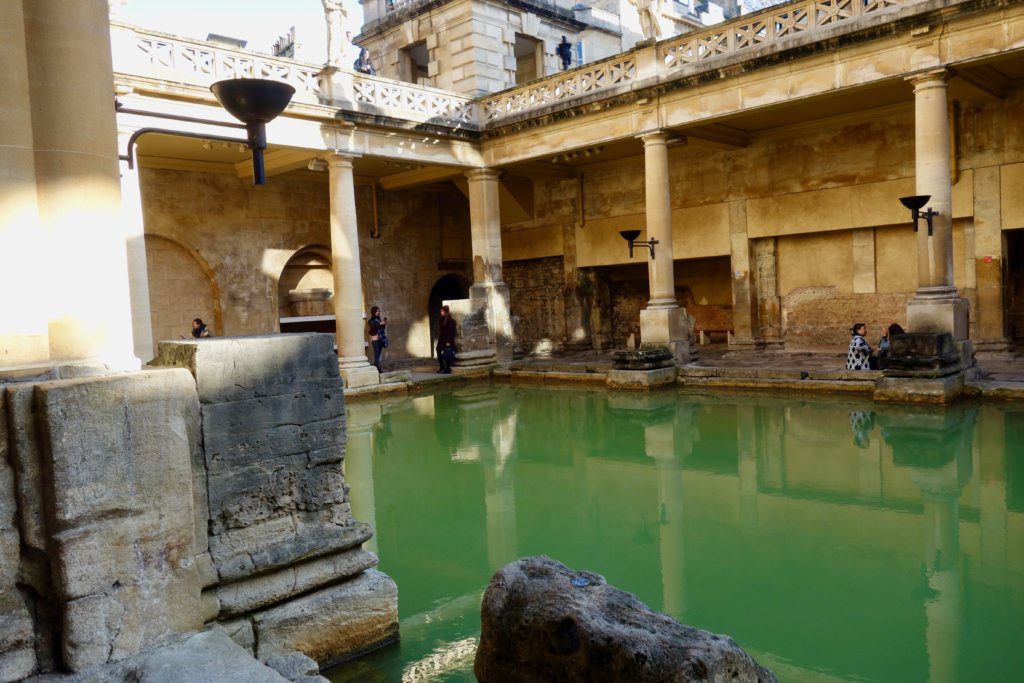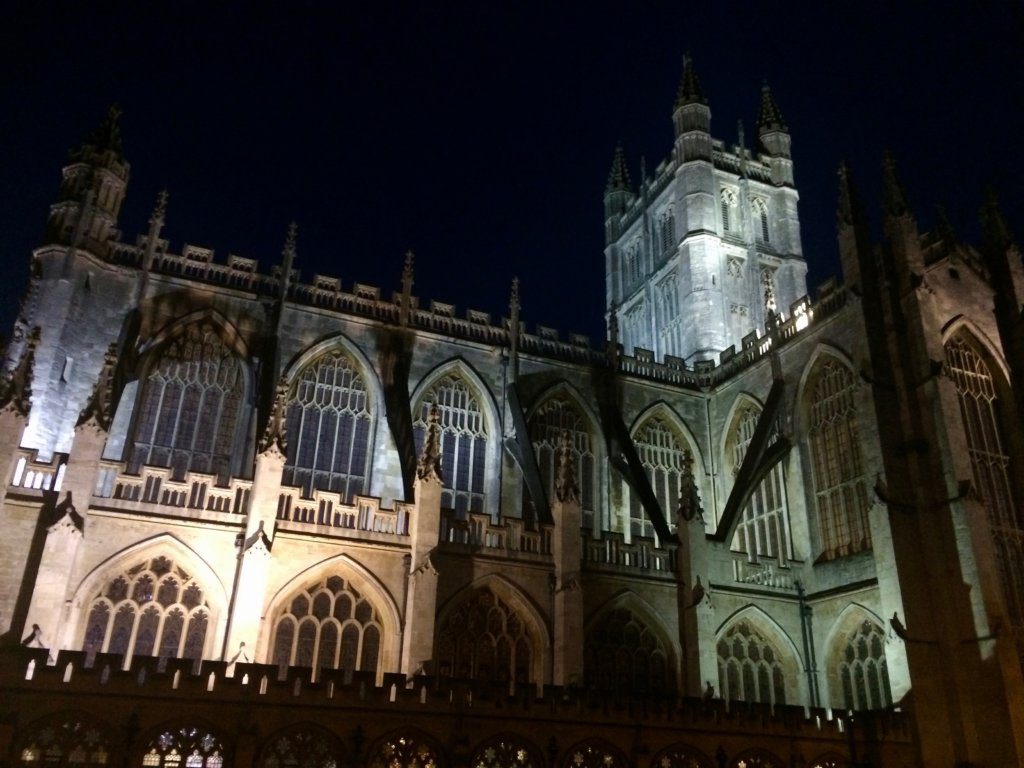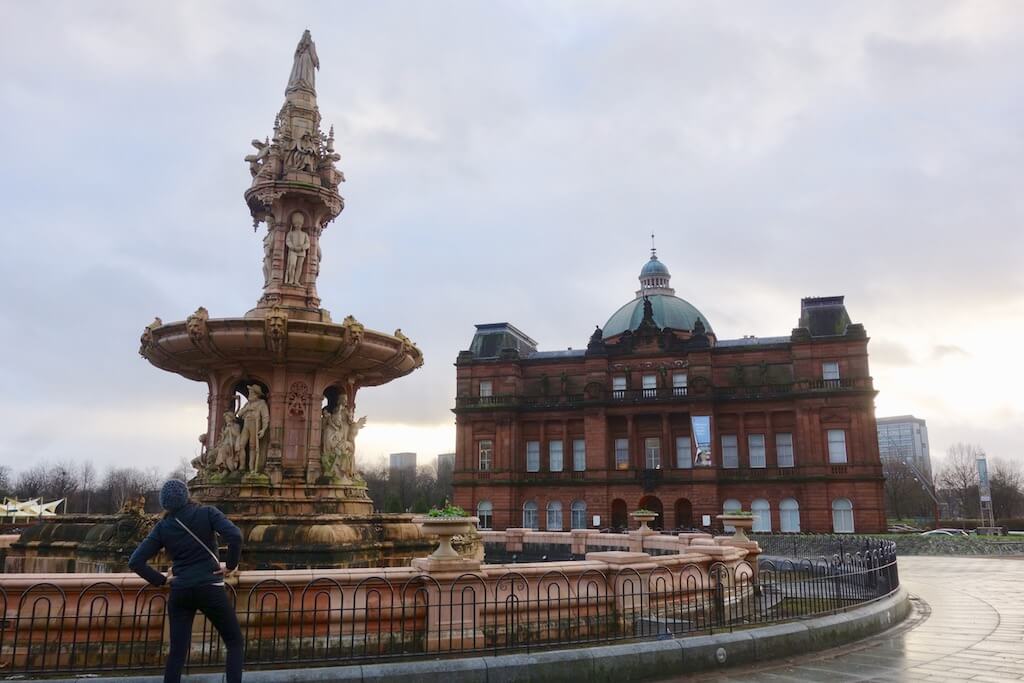The town of Bath is located in Somerset, England, and has a long, fascinating history. Bath is most known for the ancient Roman Baths that were believed to have healing properties for generations and is now considered a World Heritage Site.
While staying in a village nearby, I heard so many people say “oh you simply must go to Bath.” It was only about an hour journey by train, so I decided to take a day trip to the famous spa town.
“I really believe I shall always be talking of Bath, when I am at home again–I do like it so very much…. Oh! Who can ever be tired of Bath?” Jane Austen, Northanger Abbey
Apparently, Jane Austen hated Bath.
But there is a reason this town has attracted people for thousands of years and I really wanted to see it myself.


The Roman Baths
The Roman Baths are the most popular attraction in Bath, England. If you do only one thing during your trip to Bath, it should be this.
The main bathing pool is breathtaking. In the museum, artifacts from nearly two thousand years ago are preserved and explained through a helpful audioguide.
I learned so much in Bath.
Sometime between 60AD and 70AD, the Romans in England discovered this steaming pile of mysteriously hot mud. They attributed the warm waters to the gods, but now we know that hot springs like this form from geothermal activity deep underground.
The Romans named their town Aquae Sulis to honor the responsible gods and built the original bath and temple. They lined the bath with lead to keep it watertight, and over the next few centuries, more expansions and bathing facilities were added.
In its near two thousand year history, the Roman baths were embellished, expanded, forgotten, buried, rediscovered, excavated, and refurbished. At the Roman baths, my handy audio guide explained the history as I walked through the elaborate architecture.
Deep underground, much of the original structure remains intact and visible to visitors. The main bath had a roof over it at one point, but that collapsed and now it is open to the elements.
Due to the sunlight, the warm waters have a nice algal green hue. Still, with the heat swirling over the surface and my breath getting frosty in the cold afternoon air, I can see the appeal of this mysterious and healing hot bath.


A Lesson in Roman Bathing
Part of the tour discussed ancient Roman bathing rituals and I learned that I’ve been bathing all wrong. To get that proper Roman glow, we should all start by dousing ourselves in olive oil. Then, we should cook ourselves in a toasty caldarium so we sweat out our toxins. Next, we should scrape the slop off with half an oyster shell (budget option) or a nice metal sweat scraper (fancy option).
Of course, we should then jump into a tepid pool to close our pores. Last, we make our grand, nude, entrance to the public bath. Anyone who was anyone did this daily. Bathing was a big deal to the Romans.
At the end of the tour, I tasted the water from the hot springs. This drinking water comes from the same spring but through a different pipe, so it isn’t that lovely green color. It is quite warm, which still surprised me even though it is a hot spring, and slightly sulfuric. Naturally, I felt healed (and I haven’t gotten sick yet, so that is a good sign!)

The Bath Walking Tour
“I walk: I prefer walking.”
Jane Austen, Persuasion
Every day in Bath, there is a two-hour walking tour that starts outside the Roman Baths in the center of town. It is lead by volunteers and totally free, which I love!
What a fantastic tour!
In those two hours, I checked off everything I wanted to see in Bath. Our guide gave fantastic insights about life during the Roman times and during the Georgian era, while pointing out little details I surely would have missed on my own. Beautiful buildings are nice to look at, but his stories gave them life.

A day in the life in 18th century Bath
In the 1700s, Bath became a socialite wellness escape for wealthy Londoners. Just like the Romans, they thought there might be something special about these gurgling hot waters.
Soaking in the bath and later, drinking from it, was thought to have healing properties. So naturally, grand buildings and ballrooms were built around the baths to accommodate many visitors.
An affluent person visiting Bath in the 18th century would have started their day with a trip to the Roman baths. A doctor would determine an amount of time to soak or even an amount of water to drink, depending on the ailment.
After morning bathing (or water drinking), society members would meet for communal breakfast in the park. The park is no longer there, but you can imagine this would be quite the place to scope out the social scene for the day.
In the pump house next to the baths, visitors could sign up for dances in the evenings or purchase subscriptions to all the dances for the duration of their stay. They could also catch a glimpse at who else was on the guest list and casually ensure their name was seen too.
In the evenings, dances and balls were held in the Assembly Rooms that are maintained much to their former splendor, even today.
The chandeliers in the assembly rooms also date back to the 1700s, and they are only there today because a wise person removed them during World War two for safekeeping. The assembly rooms were damaged during World War two and then restored. Had the chandeliers been there, it’s safe to assume they wouldn’t be with us today.
These balls, which were frequented by the likes of Jane Austen, were a chance to dance, play card games, and bat eyelashes at a potential suitor.

Exploring The Streets of Bath
Next to the Roman baths is the Bath Abbey. I enjoyed a sandwich under the shadow of the Abbey while a street musician played dramatic music on a keyboard. Yes, I did pretend I was in a movie.
I had some time before my train back home, so I explored some shops on high street. Bath already had its Christmas decorations up so it wasn’t hard to start getting in the holiday spirit.
I was roaming through the shelves of cactus print stationary in a card shop and reminding myself that no, I really really don’t need another notebook, when I noticed a big hole in the floor.
It was covered over in plexiglass but down below I could see what appeared to be part of the Roman drainage system with water flowing through it. At the baths, they said that the Roman plumbing system ran under much of the city, allowing the water from the baths to be released in the river.
But to see it right there under my feet and to see that it was still working was so surprising. How cool of this shop to sneak in a fun archaeological feature?
The sunlight faded and I wandered back to the train station. I swung back past the Bath Abby to take a picture at night with it all illuminated. My keyboardist was replaced with an opera singer, so I got to enjoy another dramatic movie moment with the Abbey. Bath, you did not disappoint.


Visiting the United Kingdom?
Check out these posts for more UK travel tips and advice!
- Experience the best of London with this 4 Day London Itinerary!
- Take a walk through history at the Avebury Stones
- Plan the perfect day trip to Oxford England, even in the rain!





Oh, I enjoyed that so much. I never knew anything about the Roman Baths or Bath at all. I feel like a knowledgeable traveler now. Thank you for that wonderful look into England’s baths. I will send this to all my traveling friends. You write like and sound like a world famous experienced travel guide already!!
I take after my Nannie! 🙂
Wonderful wonderful! I love hearing about your travels. Everything sounds like such a thrilling adventure–what a fun time in your life!!
I can’t tell you how much time and money you just saved me with your wonderful story about Bath. I thought I was going to have to take the whole family to visit my granddaughter in England, which is something we all want to do, but now I feel as though I have already been there! That was really interesting and fun to read. Thanks.